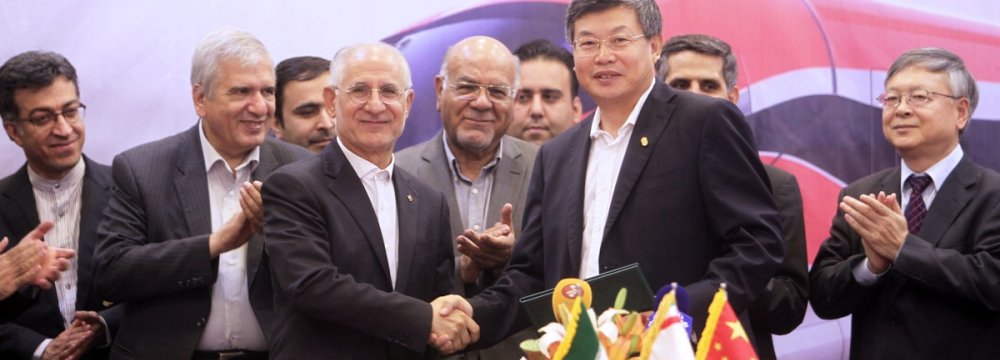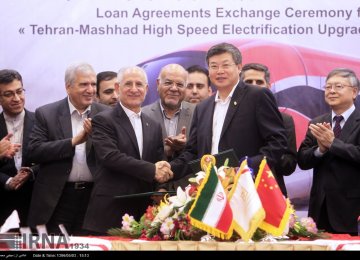China signed a contract with Iran to finance the electrification of a 926-km railroad from Tehran to the eastern city of Mashhad in Khorasan Razavi Province with a $1.5 billion loan.
As per the agreement signed between the two sides in Tehran on Tuesday, the guarantee for the loan, which is to be granted by Exim Bank of China, will be provided by Iran’s Bank of Industry and Mine, IRIB News reported.
Ali Ashraf Afkhami, CEO of the Iranian bank, was quoted as saying by IRNA that the contract was signed after 16 months of negotiations.
The electrification project will be carried out by China National Machinery Import and Export Corporation, otherwise known as CMC.
A subsidiary of China General Technology Group, CMC is an international engineering contractor in transportation infrastructure, industrial facilities and power plants. In 2014, the company constructed the Ankara-Istanbul high-speed railroad, together with China Railway Construction Corporation Limited and Turkish companies.
Iran's deputy minister of roads and urban development, Asghar Fakhrieh-Kashan, earlier said the project was worth €2.2 billion ($2.56 billion) and that two-thirds of the cost would be financed by the Chinese government at a very low interest rate.
(Update)
The remaining one-third, he added, would be covered by Chinese insurer Sinosure (China Export and Credit Insurance Corporation).
"China Exim Bank has financed 26 projects in Iran to date," Sun Ping, vice president of Exim Bank of China, was quoted as saying by IRNA on the sidelines of the signing ceremony for the financing deal in Tehran, adding that $8.5 billion worth of loans have so far been granted by the bank to fund Iranian projects.
According to Fakhrieh-Kashan, Iran’s MAPNA Group is the project's main domestic subcontractor.
The Islamic Republic of Iran Railways said last month that the Tehran-Mashhad railroad project was due to get underway, regardless of the financing process.
“All obstacles to the implementation of the project have been removed and next week, operations for the electrification of Tehran-Mashhad line will begin,” Maziar Yazdani, deputy head of Islamic Republic of Iran Railways, said on June 13.
A Strand of New Silk Road
In late 2015, He Huawu, the chief engineer of China Railway Corporation, proposed the so-called New Silk Road–a 3,200-kilometer railroad project that ultimately sees Urumqi, the capital of China's western Xinjiang Province linked to the Iranian capital Tehran, connecting Kazakhstan, Kyrgyzstan, Uzbekistan and Turkmenistan along the way, according to China’s state-owned paper China Daily.
The idea came just before international sanctions imposed on Iran over its nuclear program were lifted in January 2016, as part of a deal Tehran clinched with world powers months earlier.
From Tehran, the grand project will join Iran’s east-west network leading to Turkey and eastern Europe. It could also open a way to Europe via a developing rail route from southern Iranian ports to Azerbaijan and Europe.
The Belt and Road initiative, put forward in October 2013 by Chinese President Xi Jinping, includes several corridors through land and sea, including the New Silk Road rail route.
The route will serve as a tailwind for the transport of goods and energy between Iran and China, which have set a long-term bilateral trade target of $600 billion a year.
In February 2016, both countries tested a train journey on this line. The 32-container train took 14 days to complete the 6,462-mile (10,399-km) journey from China’s eastern Zhejiang Province through Kazakhstan and Turkmenistan–one month less than the sea route from Shanghai to the Iranian port of Bandar Abbas.
For Iran, the electrification of Tehran-Mashhad line is part of its wider rail development plan to electrify all railroads by 2025.
In a meeting with his Chinese counterpart, Xiao Jie, in China back in May, Iran's Minister of Economic Affairs and Finance Ali Tayyebnia said, “Iran’s position in Xi Jinping’s innovative plan to revive the New Silk Road is spectacular and ideal. Therefore, we intend to play an effective role in its implementation.”
Iran resolved issues regarding government guarantees during Tayyebnia’s visit to China to represent Iran in the New Silk Road Forum.
The two-day “Belt and Road Forum” started on May 14 with China and 29 other nations reaffirming their commitment to build an open economy and ensure free and inclusive trade, under the Belt and Road initiative.
Tayyebnia noted that Iran has been a part of the ancient Silk Road—a route contributing for centuries to trade and cultural exchange—stretching from Japan to the Mediterranean Sea, and intends to play a more important part in the new plan.
According to Yazdani, the electrification of Tehran-Mashhad railroad will take four years.
The route is already double-tracked and both tracks will be electrified as part of the deal with the Chinese side. This will raise the speed of the line from the current 160 kph to 200 kph, significantly reducing the duration of a trip between the two cities.






Add new comment
Read our comment policy before posting your viewpoints